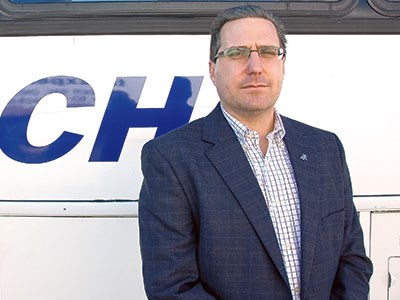If you live in a small northwestern Ontario community without a vehicle and without bus service, you could be out of luck in getting to a scheduled medical appointment, or an upcoming court date, on time.
And if you can’t score a ride from a family or friend, it might mean a pricey cab ride to another community or resorting to hitchhiking along a snowy highway.
Common Voice Northwest wants the Ministry of Transportation (MTO) to keep that mind as they work on a multi-modal transportation strategy for Northern Ontario.
Cuts in Greyhound bus service last fall prompted the coalition of community and business leaders to craft a policy paper – The Future of Inter-City Community Bus Service in Northwestern Ontario – calling for an annual provincial subsidy of up to $3.5 million to support the region’s bus lines or provide travel vouchers for individual travellers.
Iain Angus, executive director of Common Voice Northwest, said the situation is not good for the sustainability of small towns.
No bus service exists between Fort Frances-Rainy River and Kenora, from Vermillion Bay to Red Lake, and between Thunder Bay and Armstrong.
“It’s truly putting a lot of pressure on the small communities. They have a hard enough time retaining their residents as it is,” he said.
“If you’re a regular traveller, you’re going to likely move.”
Subsidizing inter-community travel is not new since Metrolinx and GO train service in the GTA, and the Ontario Northland Transportation Commission, are publicly supported.
The report assesses the transportation system in the northwest as fragmented and funded by a “hodge-podge” of ministry programming.
Social service agencies note clients in rural areas struggle to get to medical appointments or are forced to pay out-of-pocket for an expensive cab ride to meet an Ontario Works caseworker.
Sandy Smith, owner of Caribou Coach in Thunder Bay, has witnessed ridership plummet over the eight years he’s run the company.
It’s forced him to withdraw service from Hearst and run less frequently to other communities.
“We’re down close to 40 per cent of where we were at this time last year,” said Smith. “We’re going through our personal line of credit to keep scheduled service going.”
The competition he faces is almost a death by a thousand cuts.
Smith, who contributed to the Common Voice report, levels the blame on the questionable decisions made by the Ontario Highway Transport Board for introducing “unwarranted” competition on some routes.
On his Highway 11 run to Long Lac, Caribou runs neck-and-neck with a new rival carrier in competing for a half-dozen riders. The competitor was granted a permit despite Smith’s objections to the board.
“They’re basically setting up a fight.”
At one time he ran a Kenora-to-Red Lake bus, often at a loss. To offset that, Smith ran charters which self-subsidized his regular runs.
But the board granted a licence allowing a local hockey team to use their team bus for their own charters. “Now they’re a competitor and I’m getting no revenue from Red Lake.”
In other cases, he notices government-funded First Nation medical vans on shopping trips at Thunder Bay malls.
“There are eight people that should have been on the bus, eight fares.”
Such competition, he claimed, would not be permitted by the board in southern Ontario if other carriers voiced their objections.
“Up here in northwestern Ontario, they give everyone a permit and hope it eventually comes out in the wash as far as the transport board is concerned.”
Tacked onto that is the rising cost of insurance and the MTO jacking up licence renewals by “200 per cent in the last two years,” Smith said.
“They keep gouging us and expect us to continue to provide the service. But there’s no assistance anywhere.”
EMS Services in the Thunder Bay district estimates 60 to 70 per cent of their non-emergency patient transfers could arrive in their destination by bus. For the entire region, diverting stable outpatients onto buses would translate into 324 trips each year.
Doug Switzer, CEO of the Ontario Motor Coach Association, agrees a lot of money is being spent to subsidize GTA transportation and Northerners should receive a level of support.
“The government needs to get in the game of helping to make that transportation system work.”
In the North, he said, distances are greater, the population is smaller and it’s difficult for bus operations to be self-sustaining.
Switzer said the whole process of economic regulation needs review, whereby the transport board grants licences to carriers to essentially hold a monopoly on scheduled service between destinations. Sometimes the board is too loose and other times too restrictive, he said.




